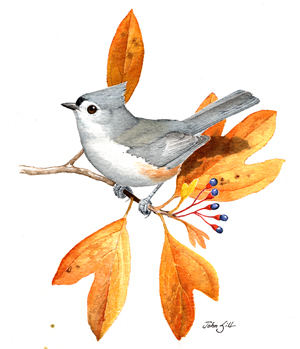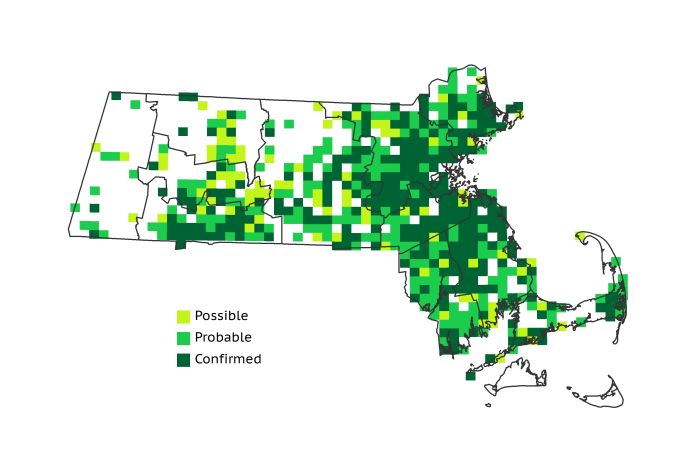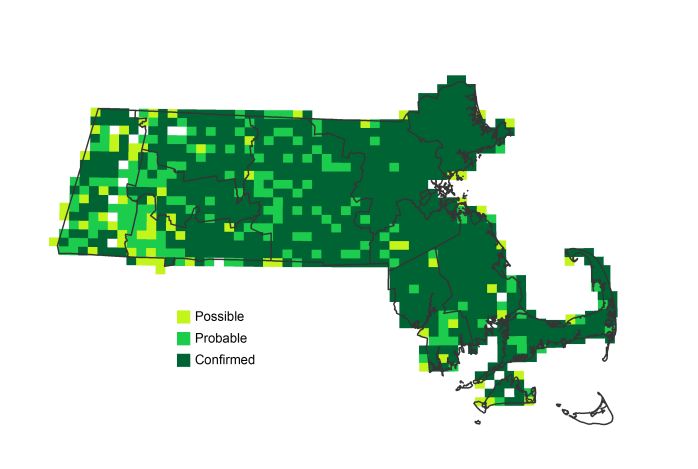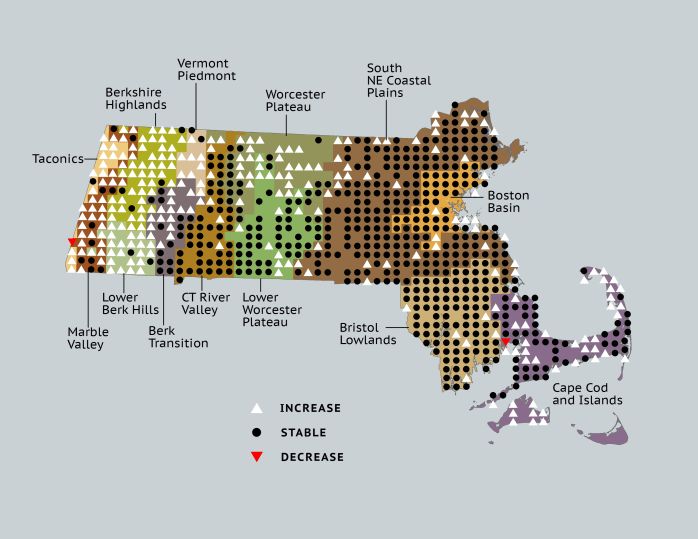Breeding Bird Atlases (BBA)
Find a Bird
Tufted Titmouse
Baeolophus bicolor

Nearly ubiquitous and likely increasing

“What is the purpose of the giant sequoia tree? The purpose of the giant sequoia tree is to provide shade for the tiny titmouse.” – Edward Abbey
When birds gather in multiple-species foraging flocks and patronize our feeders during the fall and winter, Tufted Titmice are often seen in the company of their cousins, the chickadees. When breeding season comes, Tufted Titmouse pairs establish their own territories in stands of deciduous and mixed forest and loudly stake their claim with whistled calls of peter-peter-peter. While titmice are widespread in the Commonwealth today, such plenty is not by any means a historical phenomenon.
Historic Status
Until 1959, the Tufted Titmouse was a rarity in Massachusetts. In fact, the only “titmouse” recognized by the bird observers of Massachusetts was the Black-cap Titmouse, the species that eventually came to be known as the Black-capped Chickadee. In 1959, 4 Tufted Titmice appeared on Christmas Bird Counts and 34 showed up for the 1960 census season; that number practically doubled in 1961 (Petersen & Meservey 2003). By the early 1970s, the Tufted Titmouse had saturated the state, and was breeding on a regular basis (Petersen & Meservey 2003).
Atlas 1 Distribution
Having undertaken a major range expansion into the Commonwealth, Tufted Titmice were still consolidating their territory during Atlas 1. Relatively few titmice had colonized the high western parts of the state in Atlas 1; in fact, the importance of the low-lying Connecticut River Valley as a colonization corridor from the south was readily obvious, as the region showed 86% occupancy. One can visualize the spread of Tufted Titmice east through the Lower Worcester Plateau, again hesitating to commit to the high Worcester Plateau (only 30% occupied) and instead settling in the feeder-rich suburbs of the Coastal Plains and the Boston Basin. The Bristol/Narragansett Lowlands likewise benefited from significant emigration from nearby Rhode Island, and Cape Cod was just beginning to see the titmouse become a familiar bird, though it had not yet reached Martha’s Vineyard or Nantucket as of Atlas 1.
Atlas 2 Distribution and Change
With population saturation pressures pushing Tufted Titmice eastward – after all, how many titmice can happily share a feeder in a backyard in Cambridge? – Tufted Titmice nearly saturated the eastern half of the Commonwealth, and boldly began climbing into the mountainous regions of the west, especially the Berkshire Highlands where they had settled anew in 80% of the region. The titmice eventually made it to Martha’s Vineyard, but their known distaste for flying over water has to date kept them from colonizing Nantucket. The species was absent from fewer than 100 total blocks statewide, although it seems like the invasion is not yet over, and that more feeders may yet be needed before all is said and done.
Atlas 1 Map

Atlas 2 Map

Atlas Change Map

Ecoregion Data
Atlas 1 | Atlas 2 | Change | ||||||
Ecoregion | # Blocks | % Blocks | % of Range | # Blocks | % Blocks | % of Range | Change in # Blocks | Change in % Blocks |
Taconic Mountains | 1 | 6.3 | 0.2 | 20 | 80.0 | 2.1 | 13 | 86.7 |
Marble Valleys/Housatonic Valley | 11 | 28.2 | 2.0 | 38 | 97.4 | 4.0 | 27 | 69.2 |
Berkshire Highlands | 4 | 7.3 | 0.7 | 48 | 87.3 | 5.0 | 42 | 79.2 |
Lower Berkshire Hills | 2 | 7.1 | 0.4 | 28 | 90.3 | 2.9 | 23 | 85.2 |
Vermont Piedmont | 3 | 17.6 | 0.5 | 16 | 94.1 | 1.7 | 9 | 75.0 |
Berkshire Transition | 15 | 39.5 | 2.7 | 40 | 100.0 | 4.2 | 17 | 54.8 |
Connecticut River Valley | 48 | 85.7 | 8.6 | 63 | 96.9 | 6.6 | 5 | 10.4 |
Worcester Plateau | 23 | 29.5 | 4.1 | 87 | 98.9 | 9.1 | 29 | 60.4 |
Lower Worcester Plateau | 46 | 62.2 | 8.3 | 80 | 100.0 | 8.4 | 13 | 24.1 |
S. New England Coastal Plains and Hills | 214 | 79.3 | 38.5 | 275 | 97.2 | 28.7 | 33 | 14.6 |
Boston Basin | 39 | 69.6 | 7.0 | 49 | 87.5 | 5.1 | 9 | 16.4 |
Bristol and Narragansett Lowlands | 95 | 89.6 | 17.1 | 108 | 94.7 | 11.3 | 8 | 7.9 |
Cape Cod and Islands | 55 | 40.4 | 9.9 | 106 | 73.6 | 11.1 | 39 | 32.5 |
Statewide Total | 556 | 57.4 | 100.0 | 958 | 92.4 | 100.0 | 267 | 32.2 |
Notes
The Tufted Titmouse shows a significant increasing Breeding Bird Survey trend in Massachusetts, in the New England/Mid-Atlantic Region, and in the Eastern US overall.



